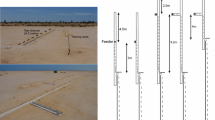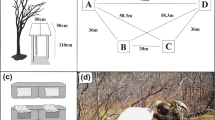Abstract
Although small-scale navigation is well studied in a wide range of species, much of what is known about landmark use by vertebrates is based on laboratory experiments. To investigate how vertebrates in the wild use landmarks, we trained wild male rufous hummingbirds to feed from a flower that was placed in a constant spatial relationship with two artificial landmarks. In the first experiment, the landmarks and flower were 0.25, 0.5 or 1 m apart and we always moved them 3–4 m after each visit by the bird. In the second experiment, the landmarks and flower were always 0.25 m apart and we moved them either 1 or 0.25 m between trials. In tests, in which we removed the flower, the hummingbirds stopped closer to the predicted flower location when the landmarks had been closer to the flower during training. However, while the distance that the birds stopped from the landmarks and predicted flower location was unaffected by the distance that the landmarks moved between trials, the birds directed their search nearer to the predicted direction of the flower, relative to the landmarks, when the landmarks and flower were more stable in the environment. In the field, then, landmarks alone were sufficient for the birds to determine the distance of a reward but not its direction.






Similar content being viewed by others
References
Batschelet E (1981) Circular statistics in biology. Academic Press, London
Biegler R, Morris RG (1993) Landmark stability is a prerequisite for spatial but not discrimination learning. Nature 361:631–633
Biegler R, Morris R (1996) Landmark stability: studies exploring whether the perceived stability of the environment influences spatial representation. J Exp Biol 199:187–193
Chamizo VD, Manteiga RD, Rodrigo T, Mackintosh NJ (2006) Competition between landmarks in spatial learning: the role of proximity to the goal. Behav Processes 71:59–65. doi:10.1016/j.beproc.2005.11.003
Cheng K (1988) Some psychophysics of the pigeon’s use of landmarks. J Comp Physiol A 162:815–826
Cheng K (1989) The vector sum model of pigeon landmark use. J Exp Psychol Anim Behav Process 15(4):366–375
Cheng K (1990) More psychophysics of the pigeon’s use of landmarks. J Comp Physiol A 166:857–863. doi:10.1007/BF00187333
Cheng K (1994) The determination of direction in landmark-based spatial search in pigeons: a further test of the vector sum model. Anim Learn Behav 22:291–301. doi:10.3758/BF03209837
Cheng K (1998) Distances and directions are computed separately by honeybees in landmark-based search. Anim Learn Behav 26:455–468. doi:10.3758/BF03199239
Cheng K, Spetch ML, Kelly DM, Bingman VP (2006) Small-scale spatial cognition in pigeons. Behav Processes 72:115–127. doi:10.1016/j.beproc.2005.11.018
Collett TS, Cartwright BA, Smith BA (1986) Landmark learning and visuo-spatial memories in gerbils. J Comp Physiol A 158:835–851. doi:10.1007/BF01324825
Dyer F (1998) Cognitive ecology of navigation. In: Dukas R (ed) Cogn. Ecol. University of Chicago Press, Chicago, Illinois, pp 201–260
Flores-Abreu IN, Hurly TA, Healy SD (2012) One-trial spatial learning: wild hummingbirds relocate a reward after a single visit. Anim Cogn 15:631–637. doi:10.1007/s10071-012-0491-0
Gibson B, McGowan F (2014) Rats average entire vectors when navigating toward a hidden goal: a test of the vector sum model in rodents. Behav Processes 102:18–24. doi:10.1016/j.beproc.2013.12.009
Gibson BM, Shettleworth SJ (2003) Competition among spatial cues in a naturalistic food-carrying task. Anim Learn Behav 31:143–159. doi:10.3758/BF03195977
Gibson BM, Wilks TJ, Kelly DM (2007) Rats (Rattus norvegicus) encode the shape of an array of discrete objects. J Comp Psychol 121:130–144. doi:10.1037/0735-7036.121.2.130
Gould KL, Kelly DM, Kamil AC (2010) What scatter-hoarding animals have taught us about small-scale navigation. Philos Trans R Soc Lond B Biol Sci 365:901–914. doi:10.1098/rstb.2009.0214
Gould-Beierle KL, Kamil AC (1996) The use of local and global cues by Clark’s nutcrackers, Nucifraga columbiana. Anim Behav 52:519–528. doi:10.1006/anbe.1996.0194
Gould-Beierle KL, Kamil AC (1999) The effect of proximity on landmark use in Clark’s nutcrackers. Anim Behav 58:477–488
Healy SD, Hurly TA (1998) Rufous hummingbirds’ (Selasphorus rufus) memory for flowers: patterns or actual spatial locations? J Exp Psychol Anim Behav Process 24:396–404
Healy SD, Hurly TA (2003) Cognitive ecology: foraging in hummingbirds as a model system. Adv Study Behav 32:325–359
Henderson J, Hurly TA, Healy SD (2006) Spatial relational learning in rufous hummingbirds (Selasphorus rufus). Anim Cogn 9:201–205. doi:10.1007/s10071-006-0021-z
Hurly TA, Healy SD (2002) Cue learning by rufous hummingbirds (Selasphorus rufus). J Exp Psychol Anim Behav Process 28:209–223. doi:10.1037//0097-7403.28.2.209
Hurly TA, Franz S, Healy SD (2010) Do rufous hummingbirds (Selasphorus rufus) use visual beacons? Anim Cogn 13:377–383. doi:10.1007/s10071-009-0280-6
Jones JE, Antoniadis E, Shettleworth SJ, Kamil AC (2002) A comparative study of geometric rule learning by nutcrackers (Nucifraga columbiana), pigeons (Columba livia) and jackdaws (Corvus monedula). J Comp Psychol 116:350–356. doi:10.1037//0735-7036.116.4.350
Kamil AC, Jones JE (2000) Geometric rule learning by Clark’s nutcrackers (Nucifraga columbiana). J Exp Psychol Anim Behav Process 26:439–453. doi:10.1037/0097-7403.26.4.439
Kelly DM (2010) Features enhance the encoding of geometry. Anim Cogn 13:453–462. doi:10.1007/s10071-009-0296-y
McGregor A, Good MA, Pearce JM (2004) Absence of an interaction between navigational strategies based on local and distal landmarks. J Exp Psychol Anim Behav Process 30:34–44. doi:10.1037/0097-7403.30.1.34
R Core Team (2014) R: a language and environment for statistical computing. R foundation for statistical computing, Vienna, Austria. http://www.R-project.org/
Roberts ADL, Pearce JM (1998) Control of spatial behaviour by an unstable landmark. J Exp Psychol Anim Behav Process 24:172–184
Roberts ADL, Pearce JM (1999) Blocking in the Morris swimming pool. J Exp Psychol Anim Behav Process 25:225–235. doi:10.1037/0097-7403.25.2.225
Shettleworth S (2009) Cognition, evolution, and behavior. Oxford University Press, Oxford
Spetch ML (1995) Overshadowing in landmark learning: touch-screen studies with pigeons and humans. J Exp Psychol Anim Behav Process 21:166–181. doi:10.1037/0097-7403.21.2.166
Spetch ML, Wilkie DM (1994) Pigeons′ use of landmarks presented in digitized images. Learn Motiv 25:245–275. doi:10.1006/lmot.1994.1014
Wagner AR, Logan FA, Haberlandt K, Price T (1968) Stimulus selection in animal discrimination learning. J Exp Psych 76(2):171–180. doi:10.1037/h0030023
Acknowledgments
We thank Ken Cheng and two anonymous reviews for their comments, which greatly improved this manuscript. We also thank Maria Tello Ramos, Rachael Marshall, Caitlin Hamilton and Jamie Dunlop for their assistance over the field season. This work was supported by the University of St Andrews, the University of Lethbridge and the Natural Sciences and Engineering Council of Canada.
Author information
Authors and Affiliations
Corresponding author
Electronic supplementary material
Below is the link to the electronic supplementary material.
Rights and permissions
About this article
Cite this article
Pritchard, D.J., Hurly, T.A. & Healy, S.D. Effects of landmark distance and stability on accuracy of reward relocation. Anim Cogn 18, 1285–1297 (2015). https://doi.org/10.1007/s10071-015-0896-7
Received:
Revised:
Accepted:
Published:
Issue Date:
DOI: https://doi.org/10.1007/s10071-015-0896-7




